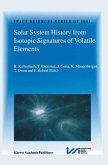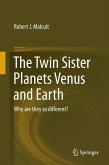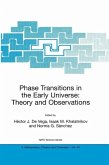High-Pressure Shock Compression of Solids V (eBook, PDF)
Shock Chemistry with Applications to Meteorite Impacts
Redaktion: Davison, Lee; Sekine, Toshimori; Horie, Yasuyuki
72,95 €
72,95 €
inkl. MwSt.
Sofort per Download lieferbar

36 °P sammeln
72,95 €
Als Download kaufen

72,95 €
inkl. MwSt.
Sofort per Download lieferbar

36 °P sammeln
Jetzt verschenken
Alle Infos zum eBook verschenken
72,95 €
inkl. MwSt.
Sofort per Download lieferbar
Alle Infos zum eBook verschenken

36 °P sammeln
High-Pressure Shock Compression of Solids V (eBook, PDF)
Shock Chemistry with Applications to Meteorite Impacts
Redaktion: Davison, Lee; Sekine, Toshimori; Horie, Yasuyuki
- Format: PDF
- Merkliste
- Auf die Merkliste
- Bewerten Bewerten
- Teilen
- Produkt teilen
- Produkterinnerung
- Produkterinnerung

Bitte loggen Sie sich zunächst in Ihr Kundenkonto ein oder registrieren Sie sich bei
bücher.de, um das eBook-Abo tolino select nutzen zu können.
Hier können Sie sich einloggen
Hier können Sie sich einloggen
Sie sind bereits eingeloggt. Klicken Sie auf 2. tolino select Abo, um fortzufahren.

Bitte loggen Sie sich zunächst in Ihr Kundenkonto ein oder registrieren Sie sich bei bücher.de, um das eBook-Abo tolino select nutzen zu können.
The subject of this book is the shock synthesis of materials, with emphasis on the applications to meteorites and cosmochemistry. The high pressures and high temperatures that meteorites encounter produce unique chemical, mineralogical, and mechanical properties, which in turn can be used to elucidate their origins and history.
- Geräte: PC
- ohne Kopierschutz
- eBook Hilfe
- Größe: 24.79MB
Andere Kunden interessierten sich auch für
![Instrumentation for Ground-Based Optical Astronomy (eBook, PDF) Instrumentation for Ground-Based Optical Astronomy (eBook, PDF)]() Instrumentation for Ground-Based Optical Astronomy (eBook, PDF)112,95 €
Instrumentation for Ground-Based Optical Astronomy (eBook, PDF)112,95 €![Solar System History from Isotopic Signatures of Volatile Elements (eBook, PDF) Solar System History from Isotopic Signatures of Volatile Elements (eBook, PDF)]() Solar System History from Isotopic Signatures of Volatile Elements (eBook, PDF)112,95 €
Solar System History from Isotopic Signatures of Volatile Elements (eBook, PDF)112,95 €![The Near Earth Asteroid Rendezvous Mission (eBook, PDF) The Near Earth Asteroid Rendezvous Mission (eBook, PDF)]() The Near Earth Asteroid Rendezvous Mission (eBook, PDF)112,95 €
The Near Earth Asteroid Rendezvous Mission (eBook, PDF)112,95 €![Introduction to Planetary Science (eBook, PDF) Introduction to Planetary Science (eBook, PDF)]() Gunter FaureIntroduction to Planetary Science (eBook, PDF)68,95 €
Gunter FaureIntroduction to Planetary Science (eBook, PDF)68,95 €![The Twin Sister Planets Venus and Earth (eBook, PDF) The Twin Sister Planets Venus and Earth (eBook, PDF)]() Robert J. MalcuitThe Twin Sister Planets Venus and Earth (eBook, PDF)72,95 €
Robert J. MalcuitThe Twin Sister Planets Venus and Earth (eBook, PDF)72,95 €![Phase Transitions in the Early Universe: Theory and Observations (eBook, PDF) Phase Transitions in the Early Universe: Theory and Observations (eBook, PDF)]() Phase Transitions in the Early Universe: Theory and Observations (eBook, PDF)160,95 €
Phase Transitions in the Early Universe: Theory and Observations (eBook, PDF)160,95 €![Formation and Evolution of Solids in Space (eBook, PDF) Formation and Evolution of Solids in Space (eBook, PDF)]() Formation and Evolution of Solids in Space (eBook, PDF)40,95 €
Formation and Evolution of Solids in Space (eBook, PDF)40,95 €-
-
-
The subject of this book is the shock synthesis of materials, with emphasis on the applications to meteorites and cosmochemistry. The high pressures and high temperatures that meteorites encounter produce unique chemical, mineralogical, and mechanical properties, which in turn can be used to elucidate their origins and history.
Dieser Download kann aus rechtlichen Gründen nur mit Rechnungsadresse in A, B, BG, CY, CZ, D, DK, EW, E, FIN, F, GR, HR, H, IRL, I, LT, L, LR, M, NL, PL, P, R, S, SLO, SK ausgeliefert werden.
Produktdetails
- Produktdetails
- Verlag: Springer US
- Seitenzahl: 248
- Erscheinungstermin: 6. Dezember 2012
- Englisch
- ISBN-13: 9781461300113
- Artikelnr.: 44058199
- Verlag: Springer US
- Seitenzahl: 248
- Erscheinungstermin: 6. Dezember 2012
- Englisch
- ISBN-13: 9781461300113
- Artikelnr.: 44058199
- Herstellerkennzeichnung Die Herstellerinformationen sind derzeit nicht verfügbar.
1 Experimental Techniques for the Simulation of Shock Metamorphism: A Case Study on Calcite.- 1.1. Introduction.- 1.2. Experimental Techniques Used for the Simulation of Shock Metamorphism.- 1.3. Observations on Recovered Calcite Specimens.- 1.4. Discussion and Conclusions.- Acknowledgments.- References.- 2 Shock Experiments on a Preheated Basaltic Eucrite.- 2.1. Introduction.- 2.2. Experiments.- 2.3. Results.- 2.4. Discussion.- 2.5. Conclusions.- Acknowledgments.- References.- 3 Structural Evolution of Quartz and Feldspar Crystals and their Glasses by Shock Compression.- 3.1. Introduction.- 3.2. Structure of Diaplectic Glass.- 3.3. Structural Evolution of Silica and Feldspar Glasses by Shock Compression.- 3.4. Concluding Remarks.- Acknowledgments.- References.- 4 Shock Reactions of Carbon-Bearing Materials and Their Cosmochemical Significance.- 4.1. Introduction.- 4.2. Occurrence of Organic Matter and Shock Waves in Cosmic Space.- 4.3. Roles of Shock Waves in the Evolution of Volatiles Including Organic Materials.- 4.4. Experimental Approach to Shock Reactions of Organic Compounds and Its Implications for Cosmochemistry.- 4.5. Outlook: Toward Origin of Organic Compounds in Space.- Acknowlegdments.- References.- 5 Shock-Induced Phase Transitions in Oriented Pyrolytic Graphite.- 5.1. Introduction.- 5.2. Experimental.- 5.3. Textures of Postshock Samples.- 5.4. X-Ray Diffraction Analysis of Postshock Samples.- 5.5. Phase Transition of Graphite to Diamond or Diamond-Like Carbon.- 5.6. Phase Transition of Graphite to Carbyne.- 5.7. Phase Transition of Graphite to Concentric Shell Carbon.- 5.8. Conclusions.- References.- 6 Shock Wave Chemistry and Ultrafine Diamond from Explosives in China.- 6.1. Introduction.- 6.2. Shock-Wave Chemistry.- 6.3. Ultrafine Diamond from ExplosiveDetonation.- 6.4. Perspectives.- References.- 7 Redistribution of Radiogenic Lead in Plagioclase During Shock Metamorphism.- 7.1. Introduction.- 7.2. Experimental Program.- 7.3. Experimental Results.- 7.4. Shock Metamorphism and Incorporation of Radiogenic Lead.- 7.5. Lunar Plagioclase.- References.- 8 Terrestrial Acidification at the KIT Boundary.- 8.1. Introduction.- 8.2. Sr Isotopes Across the KTB.- 8.3. Weathering Reactions as a Source of Sr.- 8.4. Leaching of Base Cations from the KIT Boundary Layer.- 8.5. Discussion and Conclusions.- Acknowledgments.- References.- 9 Impact Processes oflce in the Solar System.- 9.1. Solar System Ices.- 9.2. Low-Velocity-Impact Processes.- 9.3. High-Velocity-Impact of lee.- References.- Author Index.
1 Experimental Techniques for the Simulation of Shock Metamorphism: A Case Study on Calcite.- 1.1. Introduction.- 1.2. Experimental Techniques Used for the Simulation of Shock Metamorphism.- 1.3. Observations on Recovered Calcite Specimens.- 1.4. Discussion and Conclusions.- Acknowledgments.- References.- 2 Shock Experiments on a Preheated Basaltic Eucrite.- 2.1. Introduction.- 2.2. Experiments.- 2.3. Results.- 2.4. Discussion.- 2.5. Conclusions.- Acknowledgments.- References.- 3 Structural Evolution of Quartz and Feldspar Crystals and their Glasses by Shock Compression.- 3.1. Introduction.- 3.2. Structure of Diaplectic Glass.- 3.3. Structural Evolution of Silica and Feldspar Glasses by Shock Compression.- 3.4. Concluding Remarks.- Acknowledgments.- References.- 4 Shock Reactions of Carbon-Bearing Materials and Their Cosmochemical Significance.- 4.1. Introduction.- 4.2. Occurrence of Organic Matter and Shock Waves in Cosmic Space.- 4.3. Roles of Shock Waves in the Evolution of Volatiles Including Organic Materials.- 4.4. Experimental Approach to Shock Reactions of Organic Compounds and Its Implications for Cosmochemistry.- 4.5. Outlook: Toward Origin of Organic Compounds in Space.- Acknowlegdments.- References.- 5 Shock-Induced Phase Transitions in Oriented Pyrolytic Graphite.- 5.1. Introduction.- 5.2. Experimental.- 5.3. Textures of Postshock Samples.- 5.4. X-Ray Diffraction Analysis of Postshock Samples.- 5.5. Phase Transition of Graphite to Diamond or Diamond-Like Carbon.- 5.6. Phase Transition of Graphite to Carbyne.- 5.7. Phase Transition of Graphite to Concentric Shell Carbon.- 5.8. Conclusions.- References.- 6 Shock Wave Chemistry and Ultrafine Diamond from Explosives in China.- 6.1. Introduction.- 6.2. Shock-Wave Chemistry.- 6.3. Ultrafine Diamond from ExplosiveDetonation.- 6.4. Perspectives.- References.- 7 Redistribution of Radiogenic Lead in Plagioclase During Shock Metamorphism.- 7.1. Introduction.- 7.2. Experimental Program.- 7.3. Experimental Results.- 7.4. Shock Metamorphism and Incorporation of Radiogenic Lead.- 7.5. Lunar Plagioclase.- References.- 8 Terrestrial Acidification at the KIT Boundary.- 8.1. Introduction.- 8.2. Sr Isotopes Across the KTB.- 8.3. Weathering Reactions as a Source of Sr.- 8.4. Leaching of Base Cations from the KIT Boundary Layer.- 8.5. Discussion and Conclusions.- Acknowledgments.- References.- 9 Impact Processes oflce in the Solar System.- 9.1. Solar System Ices.- 9.2. Low-Velocity-Impact Processes.- 9.3. High-Velocity-Impact of lee.- References.- Author Index.







